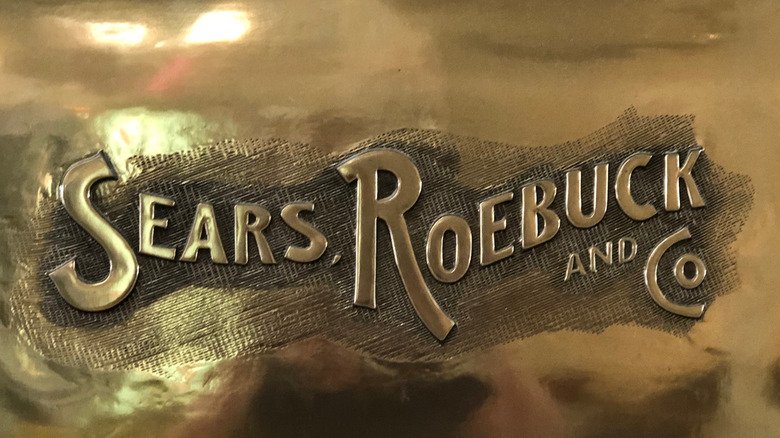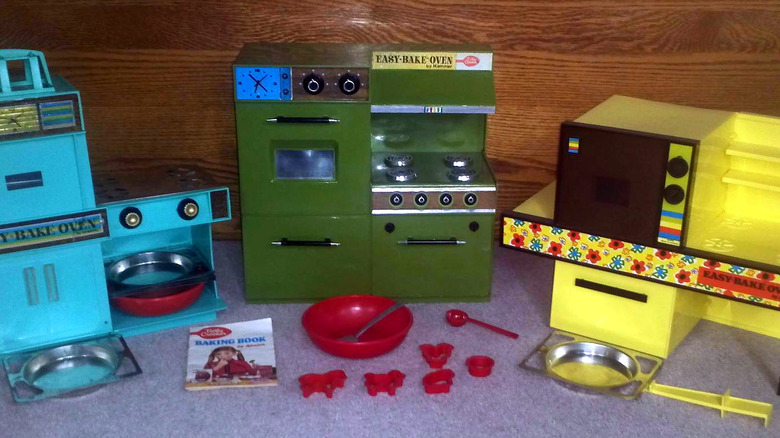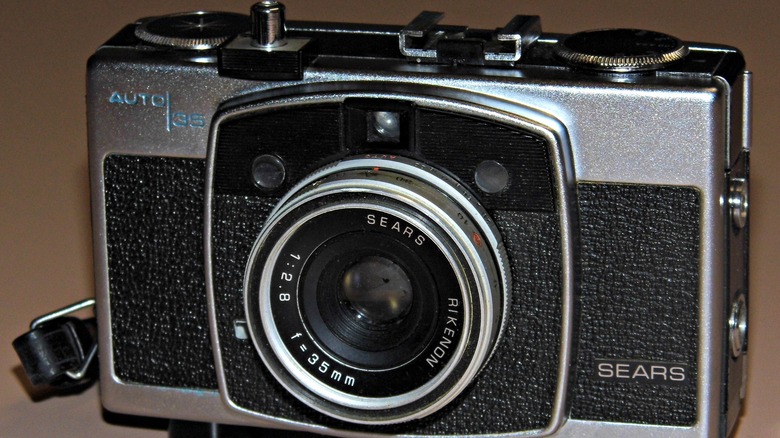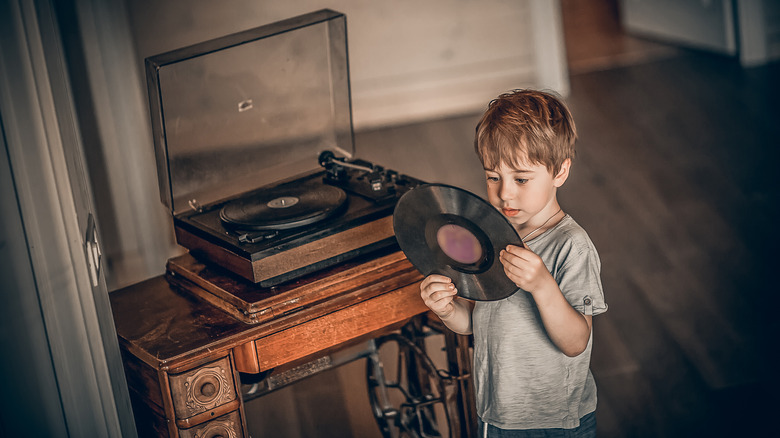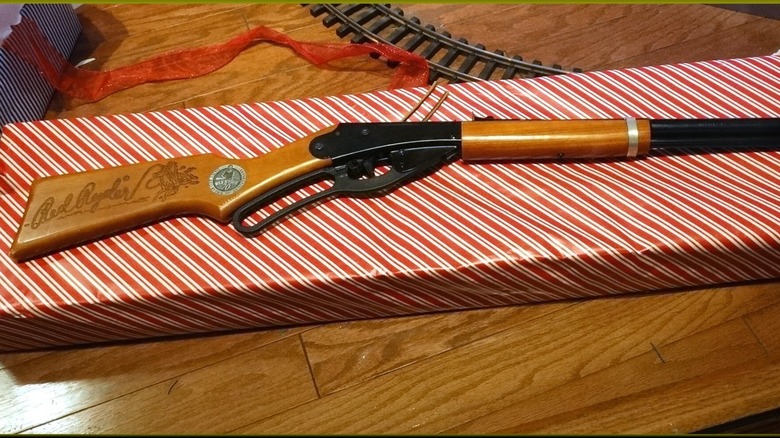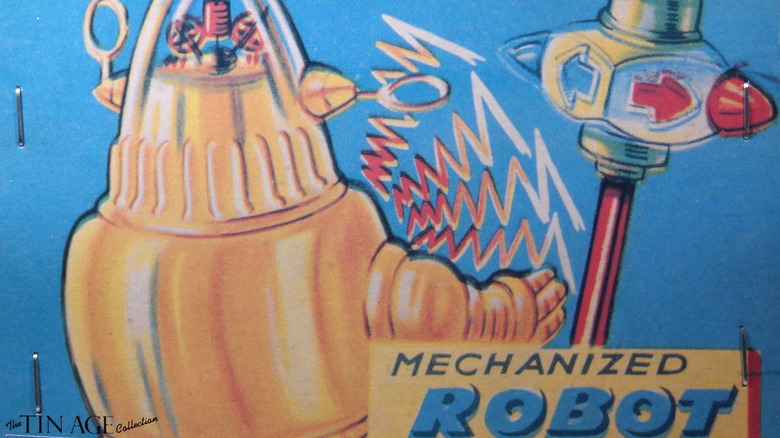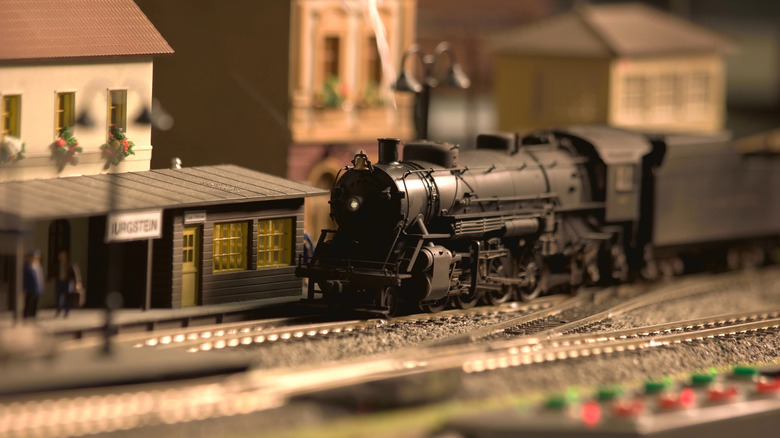Miss The Sears Catalog? Here's Where You Can Get The Same Products
We may receive a commission on purchases made from links.
People used to buy everything from the Sears & Roebuck catalog. The $50 electric guitar/amp combo on page 392, Craftsman wrenches with a lifetime guarantee, the pre-1971 Corelle dinnerware with lead paint. And houses. People bought houses from the Sears catalog... as many as 75,000 homes, according to Popular Mechanics. But in order to change America, which is exactly what Sears did, it took more than just variety.
It can be difficult to absorb today, but during most of the 20th century, Sears was one of America's most innovative companies (via CNN Business). From a start selling watches, Sears was soon selling almost anything you can imagine, from veterinary supplies to cocaine wine to appliances that eventually appeared in half of the homes in America (via History.com). In the meantime, Sears diversified its own operations by starting insurance companies, acquiring related businesses, offering widely available consumer credit ("SearsCharge Gives You Buying Power," proclaimed a 1991 catalog), and eventually started one of the first internet services, Prodigy, in partnership with IBM.
Lots of things changed over time, and gradually changed Sears' role in the economy and our daily lives. Distribution channels and logistics evolved, just-in-time fulfillment fixed (and later played havoc with) supply chains, the consciousness of overseas labor conditions made us uneasy, and energy efficiency standards took a dim view of homes built with thin prefab panels. But if you're thinking Amazon, not so fast! Let's see if we can find some sources that capture some of the charm and excitement of the sears catalog shopping experience.
Wish (and order) fulfillment
There have been lots of surprising things in the Sears catalog over the decades, from chastity belts to chickens to cocaine and heroin, complete with syringes (the drugs, that is). History Collection also mentions rifles, early automobiles, and electrified belts (about which we shall say no more)... all available via the Sears catalog.
But what the Sears Wish Book mostly sold was childhood excitement and retail therapy. Introduced during the Great Depression, the Christmas catalog omitted the workaday stuff of farm toil and home maintenance and focused on dreams. Parents didn't need Christmas lists for their children; the Wish Book fell open to the pages that were gazed at for long hours of daydreaming, that most conscious and intentional form of dreaming.
In its prime, Sears employed huge numbers of people and offered generous pay and benefits packages that would be unrecognizable to modern retail workers. A century before the Internet, Sears delivered nearly anything Americans could wish for. "It was life-changing for many rural Americans," Amanda Nicholson of Syracuse University told CNN Business. When Sears shut down its catalog operations in 1993 and entered a long, steep decline, a lot of dreams began gasping for breath. The charm, personalized service, and plain humanness of the Sears catalog experience resist algorithmic replacement, so whatever dominance Amazon has earned in the "mail-order" space via efficiency, data collection, and 26 million square feet of datacenters (via Dgtl Infra), mere web pages don't seem to capture the imagination like the Wish Book did.
We'll take a look at some of the companies competing for your family's wish fulfillment, to keep the dream of dreaming alive.
Easy-Bake Ovens and the dream of adulthood
Many toys are about emulating adulthood to some degree, but the Easy-Bake Oven upped the ante by introducing potential burns and poisoning to playtime. When you browse a few decades of Wish Books, you begin to understand that the Easy-Bake wasn't just one oven, but a series that might have been designed to keep your little chef cooking up new Christmas lists every year. And the mix refills, of which Hasbro has sold over 150 million, were a prototype of the inescapable proprietary refill subscription services of today (think SodaStream, for example).
Today, even in rural America, the market once served by the Sears catalog, it's hard to imagine a store with a toy section and no Easy-Bake Oven. Hasbro has sold 30 million of these kids' cookers... about one for every seven Gen X, Millennial, and Generation Z kids (via Stattista). There have been 11 Easy-Bake Oven models over the years, including a traditional gender role-reinforcing model aimed at Boys called the Queasy Bake Cookenator.
Incidentally, Netflix has a new show themed around the Easy-Bake Oven called Easy-Bake Battle: The Home Cooking Competition which will require contestants to use the toy to put together a winning meal and dessert (via ScreenCrush). No word on whether contestants will be allowed to use Bobby Flay's recipes from The Easy-Bake Oven Gourmet cookbook (via Goodreads).
Chemistry sets and the scientist (mad or otherwise) dream
It's not hard to see how this played out. Parents, delighted that their little girl was taking an interest in science, rushed their order to Sears for the $30 Senior Chemistry Lab Set ("Perform chemical experiments in your very own laboratory" announced the 1977 Wish Book, via WishbookWeb). By around December 27, with the fire extinguishers recharged and lawyers called, the parents settled into a pensive relief that would eventually give birth to the modern, chemical-free chemistry set. Not even kidding.
Without venturing deep into "adult chemistry sets," you won't find those open-ended stockpiles of chemical danger today. It's hard to say that's entirely good or entirely bad. On one hand, the Chemistry 60 product ("Fun Activities With No Chemicals," via Make:) is obviously absurd, both as a chemistry teaching tool and as a failure to recognize that nothing has "no chemicals." On the other hand, at least there's no Uranium (via Collectors Weekly).
From time to time, someone will have a go at recreating an old-school chemistry set, but they don't seem to stick. The best we've seen was a Kickstarter created by Kansas City's H.M.S. Beagle science store, but alas, that store is no longer in business. Your best for re-kindling the romance with slightly dangerous and education-rich chemistry education is to cook up your own with careful Internet browsing and books like Illustrated Guide to Home Chemistry Experiments: All Lab, No Lecture (via Amazon).
Microscopes and the dream of exploring unseen worlds
Science was once a thing with American children. And not just for the potential to create explosions, toxic gas releases, and chemical burns. Microscopes, along with telescopes, also promised to open new worlds to the owner. Mostly, of course, we remember them opening up new views of your slightly enlarged fingerprint ridges in exactly the same way that toy microscopes underwhelm children today. But it turns out that many of these were actually pretty good. Today's microscopes are better than ever, but we don't approach them with the same sense of wonder. Unlike almost all modern examples we could find, the creators of the Wish Book at least had the sense to try showing what kids might actually see in a microscope (via WishbookWeb).
But recreating the experience of browsing microscopes and imagining the secrets of the unseen world turns out to be mostly the domain of education now, and you can entice children by exploring resources like the American Museum of Natural History and What the Microscope Saw. A few manufacturers get it, and cultivate the possibilities of mystery with enticing pages about microscopes and related activities (via AmScope).
Guitars and the dream of stardom
Depending on the year, you might have found guitars sharing a page with an alto saxophone, various keyboards and drum kits, and maybe even an Omnicord or a $2.45 banjo if you're older than you look. But it was always the guitars that captured the imagination of kids with rockstar ambitions. That is, of all kids. The desire was so strong that the TV screens on many pages showed images of kids playing guitar (via WishbookWeb).
The Danelectro Silvertone guitars once sold by Sears have become popular with today's musicians, to the point that they are priced out of reach for young musicians. The best place to shop for guitars that might be both great and cheap today? Oddly, it's probably YouTube. Accomplished guitarists post video reviews of cheap guitars, selling the dream in an overly positive way exactly like the Wish Book did, but with proof positive of what these guitars from the likes of Firefly, Glarry, Indio, Encore, and Harley Benton can actually do. And what they can do is pretty remarkable. For kids, who often know (and therefore care) little about fair labor practices and sustainability, this is like magic: That $120 guitar sounds like something you'd hear on YouTube!
Cameras and the dream of capturing beauty
The first product shown in the 1991 Wish Book is now practically extinct in form, even though in function it dominates the world of social media. Cameras let us save still images and video as a record of what our lives are... and often as a fabrication of lives worthy of showing to others.
The camera featured in 1991 (via WishbookWeb) is a $764 LXI camcorder, but when we're talking about modern cameras we are mostly talking about DSLR and point-and-shoot still cameras. The smartphone has supplanted the point-and-shoot camera and, to the extent that they still exist at all, they are a novelty or a cheap gift. On the other hand, it has taken digital single-lens reflex (DSLR) cameras a bit longer to approach death, largely because of their use by pro photographers and videographers.
Where to buy a camera nowadays? Well, you probably shouldn't. Eric Limer says that, while an individual camera might live forever, camera tech always faces an inevitable downhill slide that ends in obsolescence, and that's where the DSLR is today (via Gear Patrol). They're bulky, expensive, and sometimes inferior to what you can accomplish with a high-res camera phone. If you can find a deal, go for it, but the best place to cultivate photographer dreams might be in the phone aisle, or in the jillion YouTube videos about DIY photographer equipment.
Record players and the dream of touching beauty
Our smartphones have replaced a lot of the vintage tech you can find in old Sears catalogs. There's no modern analog for transistor radios because there's nothing analog about "radio" anymore. But some products are so infused with wonder and lore that it's not easy to replace them with digital pacifiers, and one such device is the record player. One contributor to the This I Believe project, Michael, describes how vinyl records engage listeners physically, from the handling of the record, to the album art, to the unique hisses and pops each record collects. And this physical connection emphasizes and intensifies the act of listening.
This is a function handled by tiny digital-to-analog chips in our smartphones, not a 30-lb. suitcase that fills up a third of a dining table. But, says Michael, it's the very inconvenience that he ultimately values.
This is not, of course, how Sears pitched record players. Page 497 in the 1979 Wish Book pitched three kids' record players, each with a fantasy of its own. One was imagined to be a radio station and came complete with a microphone and an erasable programming board. The other two emphasized rock stardom: a portable that allowed you to sing along to your records through both speakers, and a tabletop model that shows both guitar player and singer (via WishbookWeb).
There's a lot going on here, so how to cultivate this experience today depends on what you're after. You can certainly pick up a record player at Amazon. The karaoke aspect can be emulated with a thousand gadgets. For the full experience minus record size and scratches, check out the Yoto Player, which replaces records with durable decorated cards in a small, screen-free player.
BB guns and the dream of shooting someone else's eye out
Maybe the goal of owning a BB run wasn't explicitly to shoot it at someone else. Though it probably was. Whatever kids dreamed of doing with their lever-action BB guns that were practically identical to the lever-action 30/30 rifles in 1,000 cowboy movies, these obviously had a pull for many children. The 1975 Wish Book sensibly grouped lever-action air rifles with the rest of its rifles, and it's hard not to notice that they have names like "El Dorado" and come with features like saddle rings, which probably had limited actual utility in a '70s Trans Am but was undoubtedly a good focal point for daydreaming.
Today's blowback BB guns and scoped pellet rifles are so dangerous that they've fallen out of favor. A pellet rifle can achieve nearly as much muzzle velocity as a .22 bullet, though not nearly as much energy, according to BB- and pellet-fun manufacturer Crosman. So another alternative has evolved for kids: the airsoft gun, which you can pick up at any department store. If you're determined to get a Red Ryder BB gun like Ralphie in "A Christmas Story," try a sporting goods store like Academy or Dick's, or Walmart, but note that you might be facing a background check in some states.
It's not hard to generate enthusiasm for guns in some children, but you might find yourself wading into uncomfortable waters like gun stores where, if you're not philosophically disinclined, you might be able to serve up some cowboy daydreams to the next generation.
Spy tools and the dream of forbidden knowledge
If you thought the idea of "Extendable Ears" was a product of J.K. Rowling's genius, think again. Kids have a tendency to spy from the moment they realize they don't know everything (though, admittedly, some people never realize this). As usual, Sears was there to help. Assuming the enemy agents don't notice the fact that your attaché case has an antenna and a camera lens, or that eight-year-olds in this neighborhood carry attaché cases, Sears could equip you with everything you needed to practice spy craft against friends, neighbors, and parents, as shown in the 1966 Christmas Book. You could even decode secret messages: What was the real meaning of this "balloon payment" your parents always whispered about in worried tones? Why does mom sigh so much when listening to Elvis? Will I get a BB gun for Christmas?
Amazon is a good source for spy kits, but don't expect the charm of the 60s and 70s products. What you'll notice is that there seems to be a lot of crossover among spies, detectives, and master thieves, at least in the minds of children, so why not create your own sweat-drenched Cold War nightmare by challenging your kids to find their new spy tools? Put together a kit full of essential tools (via WiseGeek). Oh, and hide the new kit in a neighbor's yard, because the kids are about to forget their training and tear the place up in their search.
Robots and the dream of control
Robots seem to have featured prominently in the space age and beyond. The 1962 Sears catalog shown at WorthPoint featured Mr. Mercury, Mr. Atomic, Mr. Machine, and Robot Commando, all with different purposes and levels of sophistication. Mr. Mercury could walk, bend, and lift things via remote control. By "walk" we mean roll on wheels, and by "remote" we mean as far away as the 30-inch cord would allow. By 1985 you had Omni 2000 (a kind of waiter that could manage tasks not even possible today), ChatBot (who records your message and then rolls away, presumably to get another message from someone else), and Max Steele (a 34-lb., 2-foot-tall behemoth with looks that make artificial intelligence seem like a bad idea). What's so Max about Max Steele? Well, his price, for one thing. In 1985 the robot cost $499... about $1375 in 2022 dollars (via PBS).
Robots became a fixture of toy stores instantly after 1954's Robert the Robot (via Create & Learn), and kids got into the robot-creation game itself with Lego's first Mindstorms set in 1998. Robotic toys can be had anywhere nowadays, and if you want to feel like you're actually participating in something futuristic, consider making your own. Today that means an Arduino, Raspberry Pi, or ESP microcontroller, various types of motors, and some really cool sensors. You're going to grow this passion most effectively by carefully selecting a few YouTube channels to see what they recommend.
Train sets and the dream of moving a little farther down the line
Trains seem to capture children's imaginations. It might be the dream of escape and exploring the world, or maybe it's the strange appeal of Thomas the Tank Engine and his merry band of misfits trapped on an island that seems to embody all the values of a Victorian workhouse. Toy trains came into being in the 1860s and were, by the early '50s, the top toy for boys, according to ExactRail.
You won't have any trouble finding Thomas & Friends toys, but for the best experience seek out a dedicated train hobby store. You might be overwhelmed with the history and choices of model trains, and you'll certainly be overwhelmed by some of the prices, but there are more than a half-million model train collectors between the U.S. and Canada so you won't have much trouble finding a shop. Somewhere there, under a metric ton of dust, lead-infused metal shavings, and the particulate leavings of pipe smoke, you will find a starter set and a few decades of joy waiting for you.

